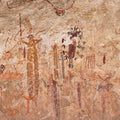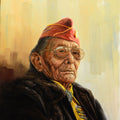Mary Sully Brought Out of the Shadows by First Solo Exhibition
By Chadd Scott on
With contemporary Native American art becoming more mainstream each passing day, America’s art museums – who’ve led this movement – are digging deeper. Having helped “break” living Native American artists like Jeffrey Gibson, Virgil Ortiz, and Cara Romero – to name just three – leading institutions are now working to bring new voices to the conversation, introducing audiences to rising figures and overlooked historical artists.
One such overlooked historical artist is Mary Sully (Yankton Dakota, 1896–1963) – born Susan Mabel Deloria on the Standing Rock Reservation in South Dakota. The little-known, reclusive artist was active between the 1920s and 1940s, creating highly distinctive work informed by her Native American and settler ancestry.
She was a great-granddaughter of successful 19th-century portraitist Thomas Sully (1783–1872). Susan Deloria expressly adopted the name of her mother, Mary Sully (1858–1916), daughter of Alfred Sully (1820–1879) and the Dakota woman Susan Pehandutawin (dates unknown), an artist in her own right.
Sully has been pulled from obscurity by her first solo exhibition, “Mary Sully: Native Modern,” debuting at the Metropolitan Museum of Art in New York in 2024 – may as well start at the top – and concluding now through September 21, 2025, at the Minneapolis Institute of Art, another of the country’s short-list most prestigious art museums. Prior to this, even most Native American art scholars would likely have given a blank stare if asked to comment on her career.
Not anymore.
Sully prominently joins the likes of Oscar Howe and George Morrison as 20th century Native artists experiencing an institutional discovery, or revival of interest, in recent years. Leading curators of American art and Modernism broadly have begun looking to these artists as important innovators either totally overlooked or greatly underrecognized.
Native American influence on contemporary art today is undeniable; Native American influence on the contemporary and modern art of the past century-plus is finally being recognized. Hats off to The Met, arguably the most prestigious art museum in the world, for helping spearhead this effort with the Sully exhibition and an upcoming solo exhibition highlighting Morrison.

'Mary Sully-Native Modern,' installation view at Minneapolis Institute of Art. Photo by Chadd Scott.
Mary Sully
Mary Sully grew up in a distinguished family of Dakota leaders. Her sister Ella Cara Deloria (1889–1971), with whom she primarily lived, was a linguistic ethnographer trained by the esteemed Columbia University anthropologist Franz Boas. Sully joined her sister on field trips, closely observing a variety of Native American beadwork, textile, and leatherwork traditions. What she saw would heavily influence her artwork.
Sully’s nephew, Vine Deloria, Jr. (1933–2005), has been referred to as “the most intellectually gifted and articulate spokesperson for Indigenous nationhood in the 20th century.” He was an author – most notably his best-selling Custer Died for Your Sins (Macmillan, 1969) – theologian, historian, and activist for Native American rights.
Sully’s great-nephew is historian Philip J. Deloria, author of Becoming Mary Sully: Toward an American Indian Abstract (University of Washington Press, 2019), the only scholarly investigation of her art and life. Phillip J. Deloria is also Professor of History at Harvard University where he focuses on the social, cultural, and political histories of the relations among American Indian peoples and the United States.
Largely self-taught, Sully produced intricately designed and vividly colored drawings mixing important aspects of her Dakota heritage with visual elements observed from other Native nations. Nothing particularly unusual there. Her work begins veering from conventional Native art with its inclusion of aesthetics from urban settings. Not any old urban setting, but New York City.
Sully lived with her sister in the Big Apple during the 1930s and 40s.
Here, her work becomes totally original for its focus on popular culture and the era’s leading celebrities. Sully and her sister regularly attended performances. She was obsessed with the era’s pop culture celebrities.
In what she called “personality prints,” Sully created abstract portraits of the day’s famous figures seen on magazine covers and shows. People like Fred Astaire and Shirley Temple.

Mary Sully, ‘Shirley Temple,’ c. 1938. Colored pencil and pigments on paper Quadriptych dimensions 40 34 × 19 in. MIA. The Driscoll Art Accessions Endowment Fund and bequest of Virginia Doneghy, by exchange
The “personality prints” followed a particular format, arranged as vertical triptychs. The top panels depict her interpretation of each individual’s characteristics. The middle panel is a pattern. The bottom panel features abstract forms reflecting various Native American cultural practices like beadwork or quillwork, the kind she would have observed growing up and on trips with her sister. They recall Plains parfleche bags or Anishinaabe bandolier bags.
“These intricate triptychs combine motifs from Western art with Dakota tradition, creating striking visual compositions that evoke the essence of her subjects’ personalities,” Valeria Piccoli, Ken and Linda Cutler Chair of the Arts of the Americas at the Minneapolis Institute of Art, said. “Through this unique lens, ‘Mary Sully: Native Modern’ challenges conventional definitions of Native American and modern art, showcasing Sully’s ability to bridge these artistic worlds with bold creativity.”
Sully added each subject’s name at the very bottom of her “personality prints,” incorporating text into her work in a radical departure from anything I’m familiar with taking place in Native American art during the first half of the 20th century and nearly anything taking place in Modernism broadly.
“Mary Sully staked a claim to Native modernism,” Philip J. Deloria said.
Sully produced more than 130 ‘personality prints,’ artworks challenging traditional notions of Native American and modern art. On view in the exhibition are recent acquisitions by the Minneapolis Institute of Art, The Metropolitan Museum of Art, and loans from the Mary Sully Foundation.

Mary Sully, ‘Fred Astaire,’ c. 1920s-40s. Colored pencil, black ink, gilt, white paint, and pastel crayon on paper. Collection of Philip J. Deloria and Margaret E. Burns-Deloria.
Native Modern
Famed Surrealist René Magritte (1898–1967) comes to mind as an artist working at the same time notably incorporating text. Famed modernist Marsden Hartley (1877–1943) similarly incorporated symbols, pattern, and abstraction when depicting specific individuals in paintings from the early 20th century. Famed Modernist Robert Indiana (1928–2018), living and working in New York a generation after Sully, similarly made paintings incorporating bold graphics and text and numbers, code for people. Something of the pop culture posters of Henri Toulouse-Lautrec (1864–1901) also.
Toulouse-Lautrec, Magritte, Hartley, and Indiana are three of the Twentieth’s most celebrated artists. That’s kind of the point. What Mary Sully – an Indigenous woman – was doing definitely relates to what these four white men doing. They have all had countless books and exhibitions. Mary Sully’s first solo exhibition comes 60 years after her death.
Why she went unrecognized is made nakedly obvious through a roughly 90-second, patently racist video playing on a small monitor in the gallery. Sully is featured in a 1944 episode of a series produced by Paramount Pictures called “Unusual Occupations,” highlighting just that. In addition to the script’s factual errors, the narrator states at the film’s opening, in an attempt to provide context for what is about to be seen and the long traditions of Native artmaking: “before the white man, with culture in one hand and rifle in the other, began to civilize the Sioux.”
Genocide rebranded as civilizing.
And proud of it, still believing the death and abuse wrought upon America’s Indigenous people by white European colonizers was ultimately in their best interest. Psychotic.
Sully, back then, wasn’t an inventive modernist breaking new ground, that role was reserved for white men. She was an oddity. A roadside attraction.
She’s at The Met now. And Mia. Finally being recognized. Many stand in line behind her waiting for their turn.



